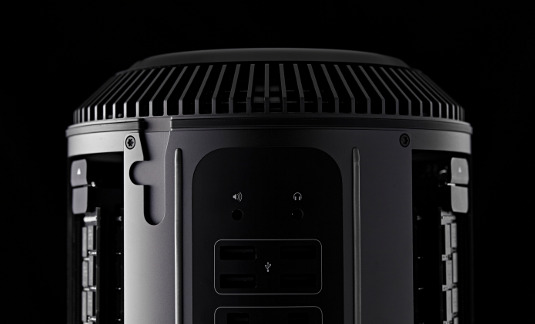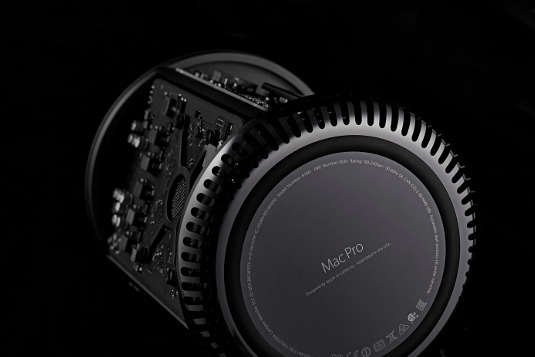Do you really need a Mac Pro?
Apple's recently released flagship machine is a thing of beauty, but is it worth its eye-watering price tag? Let's find out!
As 2013 drew to a close, our sister title MacFormat got a much-anticipated delivery: that brooding Vader-like cylinder that piqued the world's interest back in October. The Mac Pro is unquestionably a beautiful piece of hardware, but the blow to the wallet would make even the most profligate creative director think twice. So putting the alluring black shell to one side for a moment, the question is: does your studio really need that much horsepower?
Put simply, if you don't work in 4K video or high-end 3D, you'll struggle to make it break a sweat. Within that diminutive cylinder you get a multi-core processor and dual graphics cards as standard, neatly arranged around a central core that sucks out heat with the utmost efficiency. The good news for those of you who maintain compact, minimalist studios is that all this comes in a 25x17cm package, which operates almost silently.

To make the most of all that, you need software that knows exactly what to do. Unsurprisingly, Apple's own Final Cut Pro X is neatly set up to take full advantage. By drawing heavily on both graphics cards with comparatively light processor use, it enables you to comfortably edit and apply effects to multiple 4K resolution videos simultaneously, in real-time, without stuttering. The question is, how often do you need to flex that kind of creative muscle?
If you're a Creative Cloud user, the bad news is Premiere Pro (currently) relies much more on processor power than Final Cut, so you won't notice anywhere near the same level of difference compared to the previous iteration of the Mac Pro, when working on a super-demanding task like this. Don't get us wrong – with up to 12 cores, that processor is still immensely powerful. But when you're forking out that much cash, you deserve to see a game-changing difference.
Besides 4K, the other likely reason to consider an upgrade is if your studio produces a lot of demanding 3D rendering and animation. The bad news is there's currently no software support for harnessing both graphics cards simultaneously in OSX – although you could always run Windows on your Mac Pro using Boot Camp. Of course, the likes of Autodesk and Maxon are likely to respond quickly to set the record straight.
There's no doubt that the Mac Pro can muster plenty of power out of the box, but should you feel the need to upgrade its RAM, at present you're restricted to a maximum of 64GB by the number of slots – despite the fact that its predecessor supported up to 128GB. Restricted, that is, until 32GB RAM sticks are available, which is surely only a matter of time. So for creative tasks that lean heavily on the dual graphics cards, you're laughing – it's only extremely RAM-heavy processes such as working with gigantic, multi-layered Photoshop files that could outflank this beast of a machine. You would have to be an extremely high-end Photoshop CC user, of course.
Another big plus-point of the new Mac Pro is its blisteringly quick internal SSD drive, which again you're most likely to notice when rendering huge 3D files or editing 4K video. Bear in mind that it only currently supports two particular 4K displays to their maximum potential, however - MacFormat's extensive testing found that others work only at 30Hz, rather than the optimum 60Hz. These are teething problems that, once again, are likely to be fixed at a software level before long, but if you're stumping up that much cash it's all worth taking into account.
Daily design news, reviews, how-tos and more, as picked by the editors.

So, does your studio need the new Mac Pro? The simple answer is: when this amount of money is involved, you need to consider the actual difference it will make to your day-to-day workflow. As we've set out here, 4K editing and high-end 3D are likely to be the main power-drains on your current machine if you're even considering investing in one. Complex Photoshop work might be just as quick on a top-spec old Mac Pro, given the RAM limitations. As is often the case with next-gen hardware, software developers still need to catch up to avoid all those superpowers going to waste.
This article originally appeared in Computer Arts issue 224.

The Creative Bloq team is made up of a group of art and design enthusiasts, and has changed and evolved since Creative Bloq began back in 2012. The current website team consists of eight full-time members of staff: Editor Georgia Coggan, Deputy Editor Rosie Hilder, Ecommerce Editor Beren Neale, Senior News Editor Daniel Piper, Editor, Digital Art and 3D Ian Dean, Tech Reviews Editor Erlingur Einarsson, Ecommerce Writer Beth Nicholls and Staff Writer Natalie Fear, as well as a roster of freelancers from around the world. The ImagineFX magazine team also pitch in, ensuring that content from leading digital art publication ImagineFX is represented on Creative Bloq.
